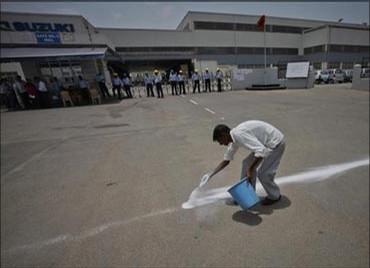We cannot draw any useful conclusions unless we have more insights about what workers’ experiences were during the strike and what they think and debate about the strike in hindsight. This will require more time and longer conversations.
Majdoor Bigul is one of the political groups which supported the striking workers and whose activists were physically attacked by company paid goons while speaking to workers in the surrounding villages. They concluded: “The Management and the Haryana govt. managed to coerce the workers’ leaders for an abject surrender in a deal brokered by the central trade unions.” (http://workersresist.net/?p=33)
We don’t think that ‘betrayal of trade union leadership’ is a satisfying explanation for defeats of workers’ struggles. It does not explain why workers, who were willing to take on the hardship and risk of two weeks factory occupation, would accept an ‘agreement’ brokered by some ‘external self-proclaimed leaders’ or AITUC bigwigs if they are not happy with it. As far as we are aware of the workers did not develop an organised structure of ‘collective decision-making’ during the occupation, which would have prevented a ‘betrayal’. They relied on their ‘leadership’ and their middlemen function. A temporary worker who friends met after the strike told us that a lot of workers were not aware of the union involvement and negotiations. The Maruti union ‘leadership’ was threatened with dismissal, for them the agreement – the chance to get their job back – was a ‘victory’.
The accusation of betrayal also implies a certain illusion concerning the character of trade unions. “We have decided to call a one-day strike to protest against the indecisive Maruti management,” Bhagwan Malik, HMSI Employees Union’s secretary said. “We will give them some time before taking a final call on the issue.” “If Maruti Suzuki fails to act on workers’ demands, we will resort to a strike at our plants in coming days,” Raj Kumar, president of Rico Auto’s workers union at the Daruhera plant, near Manesar said. “We will extend all support to Maruti employees and may go on strike to express our solidarity. If required, we will come to a common location and protest for joint demands,” Kamal Sharma, Employees’ Union president at Hero Honda’s Daruhera plant, said.
If we have a look at how some of the main ‘supporting’ unions have developed as representative legal bodies of the permanent work-force we can see that their behaviour during the Maruti strike was not ‘treacherous’, but business as usual. At Rico Auto, unionised permanent workers earn up to six times as much their temporary work-mates and the wage division has increased since establishment of the union [5]. The union at Hero Honda declined membership to temporary workers and did not support the 1,500 locked-out temporary workers during the 2008 dispute [6]. Since the establishment of the union at Honda HMSI the material division between permanent and temporary workers has increased. We quote
from an earlier article:
“Just to give the example of the union at Honda HMSI in Gurgaon. No one will deny the ‘genuine character’ of the union, it has been fought for with blood, it has not been established as a company union, no one will approach them with betrayal. Since it has been recognised in 2005, wages of the permanent workers – the union members – have quadrupled: before May 2005 permanent workers used to get around 6,900 Rs, current wages are around 30,000 Rs plus, including incentives and bonuses. At the same time permanent workers have become a minority in the plant. In 2005 there were 1,200 permanent, 1,600 trainees, 1,000 workers hired through contractors and 400 apprentices. Today there are 1,800 permanent workers and 6,500 workers hired through contractors in production departments, plus around 1,500 workers hired through contractors for cleaning, canteen, driving etc.. The temporary workers in production get around 6,800 Rs per month, less than a quarter of their permanent work-mates. The permanent workers have retained mainly supervisory positions. As part of the union-management wage agreements the permanent workers’ wages contain a large share of productivity bonus. The company wants to make them ‘benefit’ from the increased work load which has been imposed on the shoulders of the temporary work-force. The actual material power of the union has decreased, they compensate the decline by making themselves important managers of the wage hierarchy – not as ‘one act of sell out’, but as result of trade union’s essential character within the wider process of re-structuring of class relations.”
The Maruti Suzuki strike in June is also an indicator for conflicts returning to the central assembly plants. During the 1990s and early 2000s companies like Maruti were able to guarantee more stable conditions in the centres by paying relatively high wages. The general pressure on automobile companies to reduce labour costs has increased significantly since the mid-2000s. Only three months earlier workers at General Motors plant in Gujarat went on a ‘wildcat’ strike [7]. Workers at Maruti showed that material divisions can be overcome in struggle, in future workers will have to find ways to keep the struggle in their own hands.
[5]
http://gurgaonworkersnews.wordpress.com/gurgaonworkersnews-no-932/#fn1
[6]
http://gurgaonworkersnews.wordpress.com/gurgaonworkersnews-no-919/#fn6
[7]
http://www.wsws.org/articles/2011/apr2011/gmin-a15.shtml

Comments